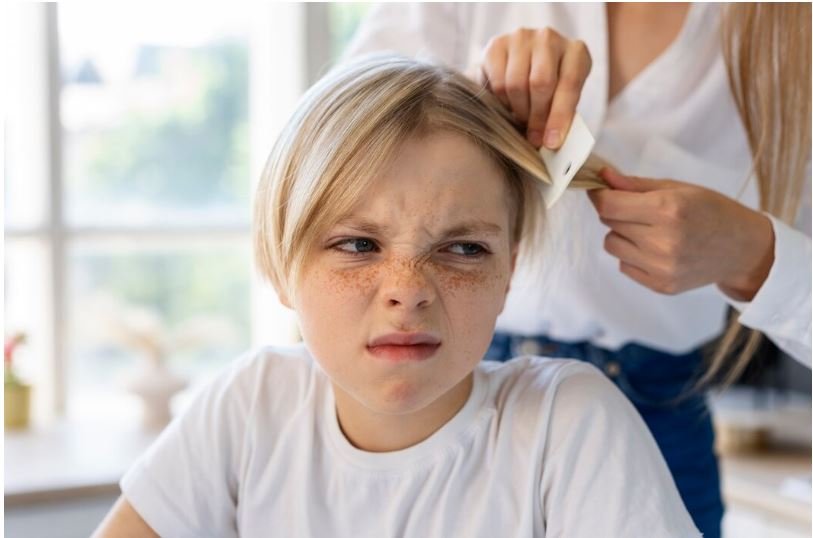
A very rare hereditary condition is Uncombable Hair Syndrome (UHS). Because of the unpredictable pattern of hair growth it induces, flat combing becomes a thing of the past. Silvery blonde, straw, or extremely shiny hair is a common appearance.
Between the ages of three months and twelve, the illness usually starts to show symptoms. Mutations in the PADI3, TGM3, and TCHH genes cause it. Hair follicle form and growth pattern are influenced by these genes.
Uncombable Hair Syndrome Information Table
| Attribute | Details |
|---|---|
| Name | Uncombable Hair Syndrome (UHS) |
| Other Names | Pili Trianguli et Canaliculi, Cheveux Incoiffables, Spun-Glass Hair |
| Causing Genes | PADI3, TGM3, TCHH |
| Age of Onset | 3 months to 12 years |
| Inheritance | Autosomal Dominant or Autosomal Recessive |
| Key Symptoms | Frizzy hair, grows in all directions, silvery or blond appearance |
| Treatment | Gentle hair care routine, soft brushes, avoiding harsh chemicals |
| Improvement Over Time | Yes, typically during adolescence |
What are the symptoms of Uncombable Hair Syndrome?
Mutations affecting the PADI3, TGM3, and TCHH genes are the root cause of UHS. Proper hair shaft development is ensured by these genes through the production of proteins. Hair grows in all sorts of weird orientations because mutations mess with the normal cylindrical growth pattern.
There are two possible inheritance types for this condition: autosomal dominant and autosomal recessive. The affected gene is passed down from parent to child in autosomal recessive disorders. One defective gene is sufficient to induce UHS in dominant inheritance.
Important Signs and Features of UHS
Dry, wiry, and coarse hair is the typical appearance of UHS. It won’t lie flat and keeps its distance from the scalp in every direction. Hair with a reflecting shine is typically straw or silvery-blond in hue. The disorder is easily identifiable due to these distinctive characteristics.
A little slower than average rate of hair growth is also possible. No other hair on the body gets impacted. There are no other health issues or bodily discomfort related symptoms; they mostly impact the scalp’s hair.
Hair Uncombability Diagnosis
It all starts with a visual inspection for a diagnosis. The unique pattern of hair development and texture is easily noticeable to doctors. By examining individual hairs under a microscope for distinctive forms, a hair shaft test can verify the diagnosis.
Mutations in PADI3, TGM3, or TCHH can sometimes be found by genetic testing. In addition to confirming the diagnosis, these tests can shed light on the pattern of heredity. The distinctive features of the illness make diagnosis easy.
Dealing with Unmanageable Hair Syndrome and Its Treatment
For UHS, there is currently no cure. But mild hair care procedures can alleviate discomfort. Important tips for taking care of UHS hair include avoiding chemical treatments, limiting heat style, and using gentle brushes.
Getting regular haircuts is another great way to keep hair under control. No amount of time spent using hair masks and conditioners will change the unusual texture of UHS hair, even though they may make it feel smoother for a while. In order to manage the condition, one must be patient and consistent.
Age as a Cure for Uncombable Hair Syndrome?
It is common for UHS symptoms to get better over time. A more consistent pattern of hair growth usually emerges during puberty. Also, the hair’s texture returns to normal, which means it’s less of a pain to style and comb. By adulthood, symptoms may have gone away entirely in certain people.
From one individual to the next, the degree of progress differs. While some people may find that their hair texture returns to normal as they enter age, others may find that moderate symptoms persist well into adulthood. This organic progress is greatly influenced by the passage of time.
Psychological and Societal Consequences of UHS
At times, a child’s self-esteem might be impacted by the way UHS hair looks. When kids have noticeable hair texture differences from their classmates, it might make them feel alone. This may cause problems with self-esteem or social anxiety.
The involvement of parents and caregivers in assisting children impacted is crucial. Steps in the right direction include boosting self-assurance and encouraging a good view of oneself. Psychological assistance in the form of counseling or therapy may be helpful in some situations.
Recent Findings and Current Investigations in Science
The genetic reasons of UHS are still being uncovered by researchers. Researchers have figured out how mutations in PADI3, TGM3, and TCHH prevent the hair shaft from growing normally. Improved diagnostic methods and new avenues for therapy are both aided by these results.
To further comprehend the patterns of inheritance of the illness, ongoing genetic research is being conducted. Possible future answers could be provided by advances in molecular therapies and gene therapy. Current treatment plans center on easing symptoms and establishing regular hair care practices.
Practical Tips for Managing UHS Hair
- Use soft brushes with natural bristles.
- Avoid harsh chemical treatments, including perms and dyes.
- Limit the use of heated styling tools like flat irons and blow dryers.
- Regularly trim hair to reduce tangles and breakage.
- Be gentle while washing or detangling hair.
FAQs About Uncombable Hair Syndrome
Q1: Is Uncombable Hair Syndrome permanent?
A: No, it often improves significantly during adolescence.
Q2: Does UHS affect overall health?
A: No, it only affects the appearance and manageability of scalp hair.
Q3: Can UHS be treated with medication?
A: No medications are available, but gentle hair care routines can help manage symptoms.
Q4: Is UHS inherited from parents?
A: Yes, it is typically inherited through autosomal dominant or recessive patterns.
Q5: Does UHS affect hair on other parts of the body?
A: No, it only affects scalp hair.
